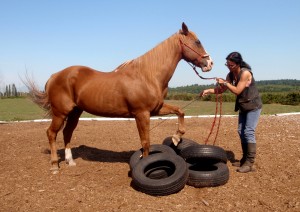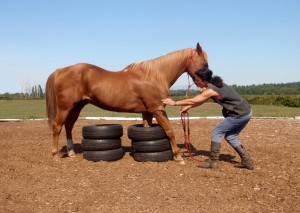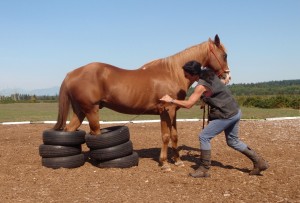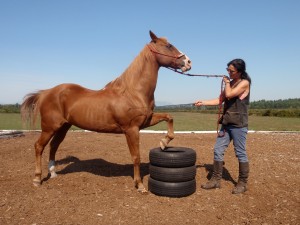How to H.E.M. – Help, Explain and Motivate your horse – Part 14
|
|
Helfen, Erklären und Motivieren – Teil 14
|
|
2) Practise the individual elements of the game:
- Touching aid on the cannon bone and voice aid “foot!” to lift the hoof (practise all four feet individually)
- Practise different intensities of this touching aid, so the hoof is lifted high enough – depending on how high the obstacle is.
- Directional aid by tugging on the rope or halter so the hoof has a chance to land in the hole.
|
|
2) Üben Sie die Einzelelemente:
- Touchierhilfe am Röhrbein und Stimmhilfe “Fuß!” zum Anheben des Hufs (alle vier Beine einzeln)
- Verschiedene gut abgestufte Intensität dieser Touchierhilfe, um den Huf hoch genug zu erheben – je nachdem wie hoch das zu übersteigende Hindernis ist.
- Richtungsweisendes Zupfen am Strick damit der Huf die Mitte treffen kann.
|
|
|
- Tickling and voice aid “no!” (calm and unemotional), when the hoof wants to land on the tyre – combined with…
- Directional aid on the rope (light tugging with instant releases) and voice aid “yayaya!” when the horse shifts his balance in the right direction, so that the foot can land in an interspace without stepping onto the rubber.
|
|
- Kitzeln und Stimmhilfe “nein!” (ruhig und unemotional), wenn der Huf auf dem Reifen absetzen will – kombi-niert mit:
- Richtungshilfe am Strick (leichtes Zupfen mit sofortigem Nachgeben) und Stimmhilfe “jajaja!” wenn das Pferd seine Balance in die richtige Richtung verlagert, so daß der Huf eine Chance hat in einem Zwischenraum zu landen ohne auf den Gummi zu treten.
|
 Give directional aids on the halter and with the whip so he doesn’t land on the tyre. Richtungsweisende Hilfe am Strick und mit der Gerte, so daß er nicht auf dem Gummi landet. |
- When you first explain something, give „hands-on“ help if necessary by putting the hoof into the tyre yourself (especially needed for the hind feet, which are much harder for the horse to place consciously!)
- You can use an assistant at the head of the horse for this and then give the touching aid on the cannon bone with the hand (on the same spot as usual and without pulling on the hoof!).
- Voice aid “fini!” when the hoof hovers in the air, to show him that it is ok to land. Caress the leg and pause – the helper feeds a treat.
- Voice aid and very clear body language for stopping “ho!” when he hoof has landed correctly. The horse should stop completely after each step (body and mind!) – pause and praise.
|
|
- Beim anfänglichen Erklären wenn nötig „handgreiflichlich“ helfen, indem man den Huf selber in den Reifen plaziert (besonders auch bei den Hinterhufen, die für das Pferd viel schwieriger bewußt zu setzen sind!)
- Hierbei kann man auch einen Assistenten am Kopf des Pferdes einsetzen, und kann die Touchierhilfe am Röhrbein mit der Hand geben (an der selben Stelle, und ohne am Huf zu ziehen!).
- Stimmkommando “fini!” wenn der Huf in der Luft schwebt, um ihn zu zeigen, daß er landen kann. Streicheln des Beins und Pause – der Helfer füttert eine Belohnung.
- Stimmhilfe und deutliche Körpersprache für Stopp “ho!” wenn der Fuß richtig gelandet ist. Nach jedem einzelnen Schritt soll ganz angehalten werden – Pause und Lob.
|
 Clear body language tells the horse to stop after each step. Klare Körpersprache zeigt dem Pferd, daß es nach jedem Schritt stoppen soll. |
- Slight tugging on rope or halter and voice aid “this way!” to continue. The whip keeps the horse straight.
|
|
- Zupfen am Strick vorwärts und Stimmhilfe “hierher!” damit es weitergeht. Die Gerte hält das Pferd gerade.
|
 To not feel trapped here takes excellent self-confidence, which all the prep-games provided. Sich hier nicht “gefangen” zu fühlen erfordert Selbstvertrauen, welches er in den Vorübungen entwickelt hat. |
Explain – Conclusion:
- Put yourself into your horse’s shoes – analyse the problems (yours as well as the horse’s) which a game may contain – and prepare properly.
- Observe how your horse learns!
- Establish a vocabulary for your communication.
- Determine the necessary steps – stay flexible!
- Always build on something, which your horse already understood and knows.
- Use pauses often, keep sessions short.
- Stop on a high note (even if only partial success!) and praise a lot! This “top performance” is what your horse will remember!
Read on in part 15:
„Help“ your horse effectively so he develops the courage to try out all challenges !
|
|
Erklären – Zusammenfassung:
- Sehen Sie die Welt durch die Augen Ihres Pferdes – analysieren Sie die Probleme (Ihre sowie die des Pferdes), die in einem Spiel enthalten sein könnten – und bereiten Sie sich gut vor.
- Beobachten Sie genau wie Ihr Pferd lernt!
- Begründen Sie ein Vokabular für die gemeinsame Kommunikation.
- Legen Sie die notwendigen Schritte fest – bleiben Sie flexibel!
- Bauen Sie immer auf etwas auf, das Ihr Pferd schon verstanden hat.
- Pausieren Sie oft, halten Sie die Lernphasen kurz.
- Hören Sie immer nach einer Bestleistung auf – auch wenn das nur auf einen Teil (einen kleinen Schritt der Lernphase) der Übung zutrifft. Diese Bestleistung (gefolgt von viel Lob) wird Ihr Pferd im Gedächtnis abspeichern!
Bitte lesen Sie weiter im Teil 15:
„Helfen“ Sie Ihrem Pferd effektiv, damit es den Mut entwickelt, alle Herausforderungen anzunehmen !
|
|
|
|
|





